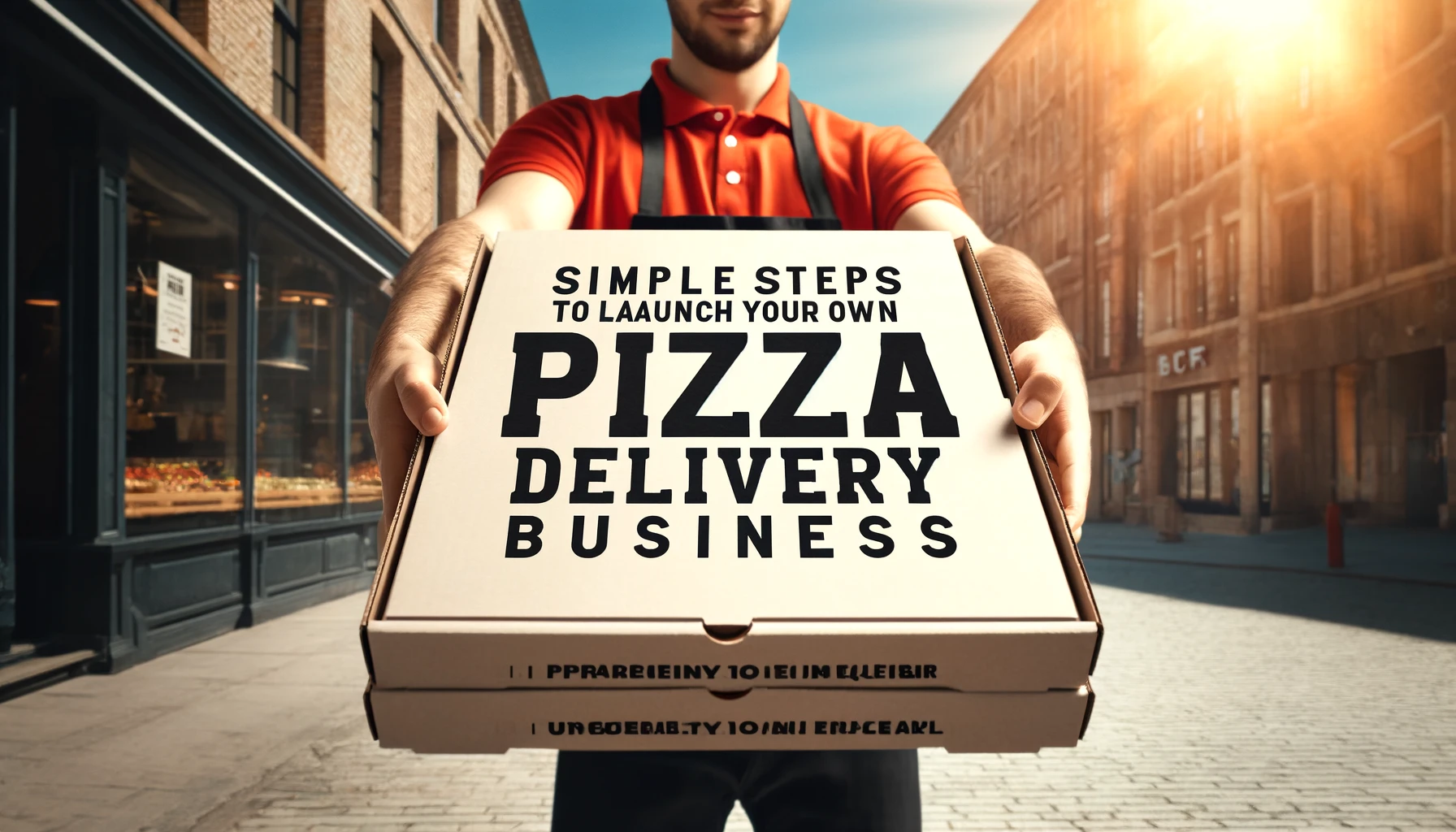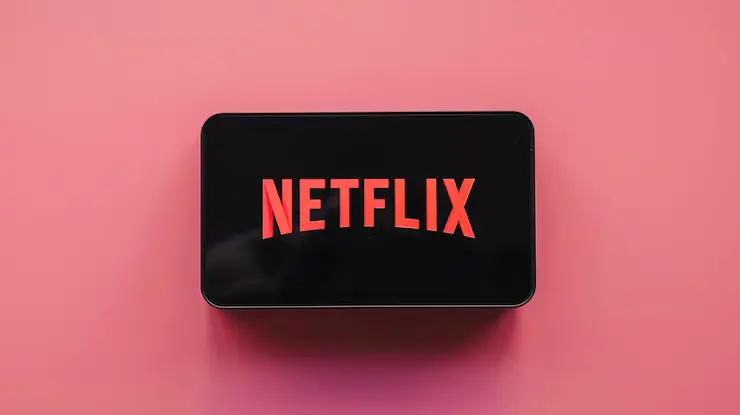With the rise of online ordering and delivery services, launching a pizza delivery business has become a lucrative opportunity for entrepreneurs. Whether you’re a passionate pizza lover or an entrepreneur seeking a profitable venture, this guide will walk you through the steps to establish your own pizza delivery business successfully. By following this comprehensive guide, you’ll have a clear roadmap to launch and grow your pizza business and beyond.
Why Start a Pizza Delivery Business?
Pizza is one of the most popular and beloved fast-food items globally. The combination of convenience, customizability, and universal appeal makes it a perfect option for a delivery-based business model. With modern technology, launching a pizza delivery app is easier than ever, giving customers a seamless online pizza ordering experience. By leveraging digital platforms, you can tap into the growing demand for food delivery services and increase your chances of building a successful restaurant delivery startup.
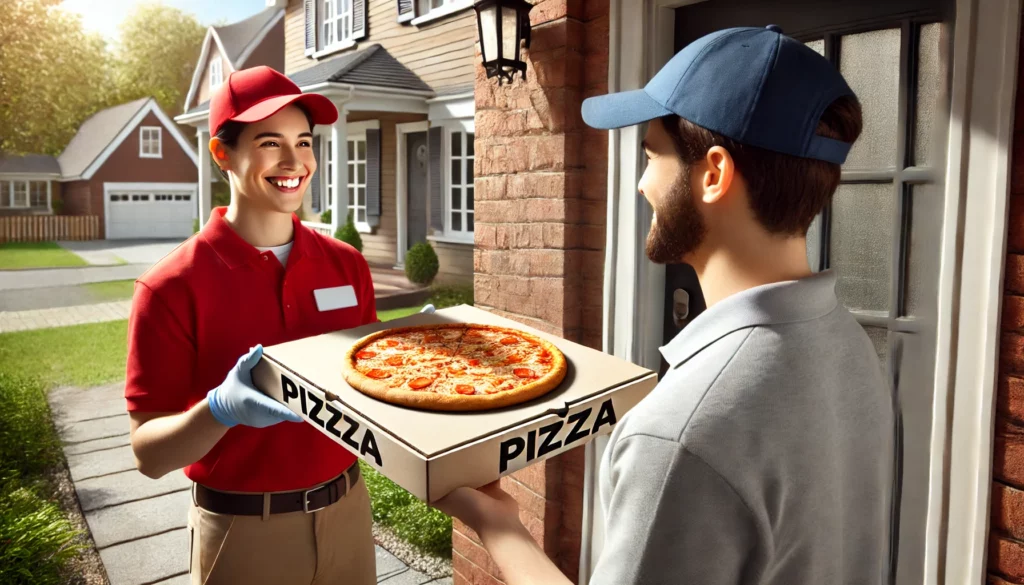
Market Trends for the Pizza Delivery Business
The pizza delivery industry is booming, driven by changing consumer habits, advancements in technology, and the global shift toward convenience. Here are some key market trends shaping the pizza delivery business:
1. Digital Ordering Dominance
- Online Ordering: More than 60% of consumers prefer placing their orders online through a pizza delivery app or website, as it offers convenience and speed.
- Mobile-First Approach: As smartphone penetration continues to grow, businesses are investing heavily in mobile apps to offer seamless online pizza ordering experiences. According to reports, over 45% of digital food orders are made via smartphones.
In fact, according to global food delivery market trends, the industry is expected to grow significantly, driven by consumer demand for convenience and technological advancements.
2. Customization and Health-Conscious Menus
- Personalization: Customers are increasingly looking for customization options in their pizzas, from crust type to ingredients. Personalized ordering experiences can lead to higher customer satisfaction.
- Healthy Options: Gluten-free, low-carb, and vegan pizzas are gaining popularity as more consumers opt for healthier food choices.
3. Integration of Advanced Technology
- AI and Chatbots: Restaurants are adopting AI-powered chatbots to take orders and enhance customer service.
- Drones and Autonomous Delivery: As a futuristic trend, autonomous vehicles and drones are being tested by major food delivery companies to optimize delivery times and reduce human labor costs.
4. Sustainable and Eco-Friendly Practices
- Eco-Friendly Packaging: With consumers becoming more environmentally conscious, pizza delivery businesses are shifting to biodegradable packaging and reducing waste.
- Local Sourcing: Using locally sourced, fresh ingredients is another emerging trend that appeals to health-conscious consumers.
5. Subscription Services and Loyalty Programs
- Subscription Models: Many pizza delivery businesses are introducing subscription services, offering regular deliveries at discounted rates. This provides businesses with a predictable revenue stream and increases customer loyalty.
- Loyalty Programs: Offering rewards for frequent customers through digital apps helps businesses retain their customer base and encourage repeat orders.
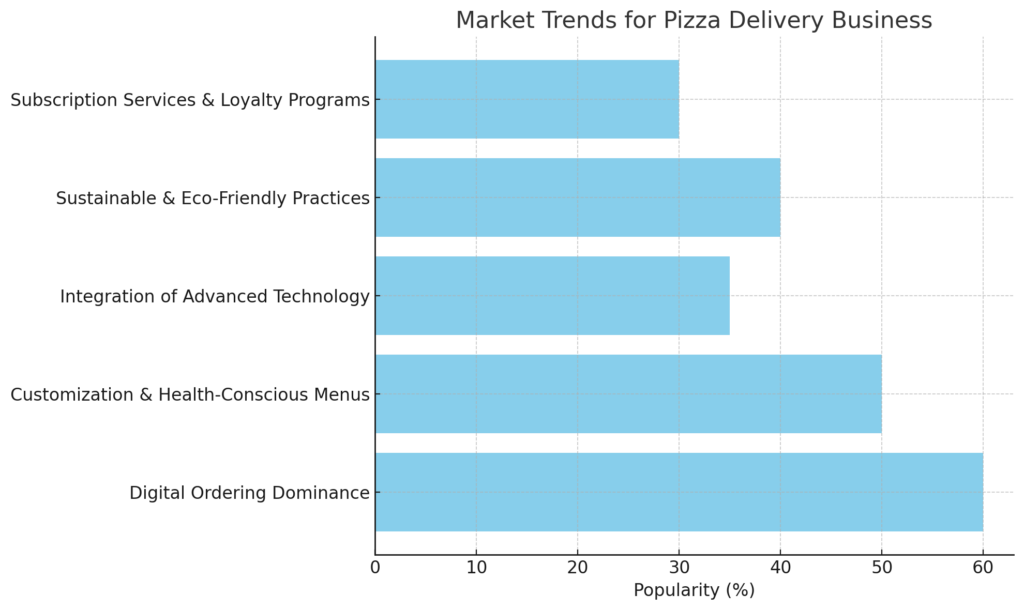
Step-by-Step Guide to Starting Your Pizza Delivery Business
1. Conduct Market Research
Before jumping into the pizza delivery business, it’s essential to understand the market demand and competition. Research your local area to identify potential customers, their preferences, and what your competitors are offering. Focus on:
- Target Audience: Are you targeting families, office workers, or students? Understanding your demographic helps tailor your menu and marketing strategy.
- Competitor Analysis: Check out other pizza delivery businesses and online food delivery services. What are their pricing strategies, and how can you differentiate your pizza business?
- Trends in Food Delivery: Stay updated with trends in the food delivery business, such as eco-friendly packaging, subscription services, or vegan/gluten-free pizza options.
2. Develop a Solid Business Plan
A well-thought-out business plan will serve as the foundation of your pizza delivery business. Include key elements like:
- Business Model: Decide whether you want to operate a physical pizza restaurant with delivery services or opt for a cloud kitchen that solely focuses on delivery.
- Startup Costs: Estimate costs for setting up your kitchen, ingredients, staff, delivery vehicles, and technology (app or website).
- Revenue Projections: Forecast your revenue based on projected pizza orders, pricing, and delivery fees.
- Growth Strategy: Plan how you will scale your business. Will you expand to more delivery areas or add a wider menu?
3. Legal Formalities and Permits
Starting any food-related business involves several legal steps:
- Business Registration: Register your pizza delivery business with the appropriate government authority.
- Licenses and Permits: Obtain health department approvals, food handling certifications, and local business permits.
- Insurance: Secure insurance for your business, including liability coverage for your delivery drivers and kitchen operations.
4. Build an Online Presence
A strong online presence is key to the success of your pizza delivery business. Today’s consumers prefer the convenience of ordering food online, so setting up a robust digital platform is crucial.
- Pizza Delivery App: Develop a user-friendly pizza delivery app that allows customers to browse the menu, place orders, and track deliveries in real time.
- Online Pizza Ordering Website: Build a mobile-optimized website with integrated online ordering functionality.
- Social Media and Marketing: Engage with your audience on platforms like Instagram and Facebook. Showcase mouth-watering images of your pizzas and offer promotions to attract new customers.
5. Create a Menu That Stands Out
Your menu is the heart of your pizza delivery business. While traditional pizzas like Margherita and Pepperoni are staples, offering unique and customizable options will attract more customers. Consider:
- Signature Pizzas: Develop exclusive pizza recipes with unique ingredients or themes.
- Healthy Options: Cater to the health-conscious crowd with gluten-free crusts, low-carb options, and vegan cheese.
- Seasonal Specials: Introduce limited-time offers or seasonal pizzas to create buzz and keep customers coming back.
6. Streamline Your Delivery Process
Efficient delivery is crucial to the success of your pizza delivery business. Customers expect their food to arrive fresh and on time.
- Hire Reliable Drivers: Invest in professional, courteous drivers who know the local area well and can deliver pizzas quickly.
- Invest in Delivery Technology: Use GPS tracking and route optimization to ensure timely deliveries.
- Packaging Matters: Ensure that your pizzas are packaged securely to retain heat and prevent damage during transit.
7. Promote Your Business and Build a Brand
Once you’re ready to launch, it’s time to spread the word and build brand awareness.
- Local Advertising: Leverage local newspapers, radio stations, and community events to introduce your business.
- SEO and Online Ads: Optimize your website and pizza delivery app for search engines, using relevant keywords like “online pizza ordering” and “best pizza delivery near me.” Run paid ads on Google and social media to reach a wider audience.
- Loyalty Programs: Encourage repeat orders by offering loyalty programs, discounts on bulk orders, or a subscription service.
Steps to Develop a Pizza Delivery App
Creating a pizza delivery app involves several critical steps, from ideation to deployment. Below is a step-by-step guide for developing a fully functional pizza delivery app:
1. Define Your Business Model and App Features
- Business Model: Decide whether your app will focus solely on pizza delivery or if it will include other food items. This decision will impact the app’s design and features.
- Core Features:
- User Registration and Login: Allow users to sign up via email, phone number, or social media.
- Menu Management: Showcase different pizza options, customizable ingredients, and pricing.
- Order Tracking: Provide real-time updates on order status, from preparation to delivery.
- Payment Integration: Offer secure payment options, including credit/debit cards, digital wallets, and COD.
- Delivery Management: A section for managing delivery partners and their routes.
- Push Notifications: Notify customers about special deals, order updates, and delivery status.
- Review and Ratings: Let users review the food and delivery service to enhance customer engagement.
2. Conduct Market Research
- Analyze the top competitors in the pizza delivery business.
- Identify their app’s strengths and weaknesses.
- Focus on improving their shortcomings in your app.
3. Design the User Interface (UI) and User Experience (UX)
- Wireframe Design: Create the wireframes for all screens, including the homepage, product pages, checkout process, and delivery tracking.
- UI Design: Design an intuitive, mobile-responsive interface that is visually appealing and easy to navigate.
- UX Optimization: Ensure that the user flow is smooth, from browsing pizza options to placing the order and tracking it.
4. Choose the Right Tech Stack
- Front-End Development: Use frameworks like React Native or Flutter for cross-platform development (iOS and Android).
- Back-End Development: Consider using Node.js or Laravel for the server-side, ensuring seamless API integration with the front end.
- Database: Choose robust databases like MongoDB or MySQL to store user information, menu data, and orders.
- Third-Party APIs:
- Payment Gateway API: Integrate PayPal, Stripe, or Razorpay for secure transactions. Selecting a reliable payment gateway is essential for your pizza delivery app. You can explore some of the best payment gateway solutions to ensure secure transactions for your customers.
- Geolocation API: Use Google Maps API for accurate delivery tracking.
- Push Notifications: Utilize services like Firebase Cloud Messaging for notifications.
5. Develop and Test the App
- Front-End Development: Begin developing the customer-facing front end, ensuring that it’s responsive across devices.
- Back-End Development: Set up databases, payment gateways, and delivery management systems.
- Testing: Conduct rigorous testing, including:
- Unit Testing: Test individual components and features.
- Integration Testing: Ensure that front-end and back-end elements work together seamlessly.
- User Acceptance Testing (UAT): Have a test group use the app and provide feedback.
- Load Testing: Simulate heavy user traffic to see how the app handles it.
6. Deploy and Launch
- App Store Deployment: Submit the app to the Apple App Store and Google Play Store. Follow their respective guidelines for approval.
- Marketing and Promotion: Launch a digital marketing campaign to promote the app. Utilize social media platforms, email marketing, and local advertising to attract users.
- Post-Launch Monitoring: Continuously monitor app performance, address bugs, and gather user feedback to implement future updates.
Read More “DoorDash Pricing Model and Strategy: How It Drives Success in 2024“
Want to Start Your Own Pizza Delivery Business?
We’ll help you launch a scalable, tech-powered solution with
online ordering, real-time tracking, and easy payments.
Ready to serve success?
Cost of App Development
The cost of developing a pizza delivery app varies depending on various factors such as features, complexity, technology stack, and the development team’s rates. Here’s a breakdown of the potential costs:
1. Basic App Development
- Features: Simple user registration, menu, basic order placement, payment gateway, and order tracking.
- Cost Estimate: $10,000 – $20,000
2. Mid-Level App Development
- Features: In addition to the basic features, this app includes push notifications, loyalty programs, delivery route optimization, and detailed analytics.
- Cost Estimate: $20,000 – $50,000
3. Advanced App Development
- Features: Highly advanced app with AI-driven personalized recommendations, real-time delivery tracking, multi-language support, integrated chatbots for customer service, and robust analytics.
- Cost Estimate: $50,000 – $100,000+
Breakdown of Costs:
- UI/UX Design: $3,000 – $10,000
- Front-End Development: $5,000 – $20,000
- Back-End Development: $10,000 – $30,000
- Third-Party API Integration: $1,000 – $5,000 (depending on payment gateways, geolocation APIs, etc.)
- Testing: $2,000 – $5,000
- Deployment and Maintenance: $2,000 – $8,000 (yearly costs for hosting, app updates, bug fixes, etc.)
Factors Affecting App Development Costs:
- Geographical Location: Development costs are lower in regions like Eastern Europe, India, and Southeast Asia compared to the US or Western Europe.
- Team Size and Expertise: Hiring a more experienced team with specialized developers may cost more but yield higher-quality results.
- Timeframe: Expedited development schedules may require more resources and therefore cost more.
Developing a pizza delivery app requires careful planning, a well-thought-out feature set, and a clear business model. While the initial investment may seem high, a well-executed pizza delivery app can generate significant revenue by streamlining the customer ordering experience and improving operational efficiency.
| App Development Stage | Typical Development Cost | Miracuves Special Offer |
|---|---|---|
| Basic App Features | $10,000 – $20,000 | Included in $2499 |
| – User registration and login | ||
| – Menu and order management | ||
| – Payment gateway integration | ||
| Mid-Level App Features | $20,000 – $50,000 | Included in $2499 |
| – Push notifications | ||
| – Delivery tracking | ||
| – Loyalty programs | ||
| Advanced App Features | $50,000 – $100,000+ | Included in $2499 |
| – Real-time delivery updates | ||
| – AI-driven recommendations | ||
| – Subscription services | ||
| App Deployment and Maintenance | $2,000 – $8,000 (per year) | Included in $2499 |
| Total Development Cost | $50,000 – $100,000+ | $2499 (all-inclusive) |
Miracuves Offer
Miracuves is offering a complete pizza delivery app solution with all essential features and advanced capabilities for just $2499—a fraction of the typical cost. This includes user-friendly features, payment integration, delivery tracking, and more, along with ongoing maintenance.
This table illustrates how Miracuves provides exceptional value by delivering a high-quality, feature-rich app at a highly competitive price.
Pizza Business Tips for Long-Term Success
To ensure sustained growth, always be on the lookout for ways to improve and expand your pizza delivery business:
- Customer Feedback: Continuously collect feedback to improve your menu, service, and delivery.
- Adapt to Trends: Stay flexible and adapt to changing consumer preferences, whether it’s by offering new toppings, quicker delivery options, or supporting more payment methods like digital wallets.
- Monitor Performance: Use analytics to monitor sales, track delivery times, and identify areas for improvement.
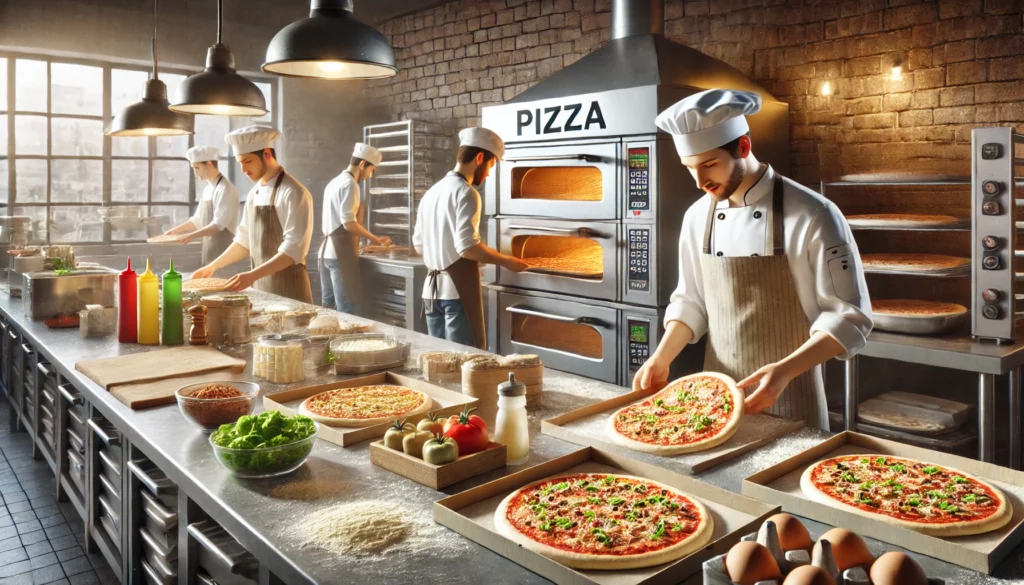
Challenges in Starting a Pizza Delivery Business
While the pizza delivery business has great potential, it comes with its own set of challenges that you need to anticipate and plan for:
1. High Competition
- Local and Chain Competitors: Pizza delivery is a highly competitive space, with both established chains (like Domino’s and Pizza Hut) and local pizzerias vying for market share. Standing out from the crowd can be difficult, especially for new businesses.
2. Rising Operational Costs
- Ingredient Costs: Fluctuations in the cost of ingredients like cheese, flour, and vegetables can directly impact profitability.
- Labor Costs: Hiring reliable kitchen staff and delivery drivers can add to the operational costs, especially in areas where minimum wage laws are increasing.
- Delivery Logistics: Managing the logistics of delivery—ensuring timely deliveries, managing fuel costs, and maintaining vehicles—can also pose a challenge.
3. Customer Retention
- Building Brand Loyalty: With so many pizza delivery options available, retaining customers and encouraging repeat orders can be a challenge. Competitors may lure your customers with attractive discounts and loyalty programs.
4. Managing Technology
- App Development and Maintenance: A seamless user experience in your pizza delivery app is essential. Poor app performance, long loading times, or a cumbersome ordering process can lead to customer dissatisfaction.
- Integration of New Tech: Keeping up with tech advancements, like AI-driven personalized recommendations or drone deliveries, may require substantial investment in technology.
5. Meeting Consumer Expectations
- Fast Delivery: Customers expect fast and accurate delivery, and failing to meet these expectations can result in negative reviews and lost business.
- Food Quality: Maintaining pizza quality during delivery, ensuring it arrives hot and fresh, is crucial for customer satisfaction.
Market Penetration Strategies for a Pizza Delivery Business
To overcome these challenges and capture market share, consider the following strategies:
1. Focus on Niche and Customization
- Niche Offerings: Instead of competing with large chains, focus on niche markets such as vegan pizzas, gluten-free options, or gourmet pizza selections. This helps differentiate your business and attract specific customer groups.
- Customization: Allow customers to fully customize their pizzas. Offering unique toppings, crust styles, and flavor combinations can enhance the customer experience and increase order value.
2. Invest in Digital Marketing
- SEO and Local Search Optimization: Optimize your pizza delivery app and website for local SEO by using keywords like “best pizza delivery near me” and “online pizza ordering.” This helps your business appear in local search results.
- Social Media Presence: Build a strong social media presence on platforms like Instagram, Facebook, and TikTok by showcasing behind-the-scenes pizza-making, customer testimonials, and special promotions.
- Paid Advertising: Use Google Ads and social media ads to reach a targeted local audience. For example, offer discounts on first-time orders through your pizza delivery app.
3. Create a Loyalty Program
- Rewards for Frequent Orders: Implement a points-based loyalty program where customers earn points for every order, which can be redeemed for free pizzas, discounts, or exclusive deals.
- Referral Program: Encourage word-of-mouth marketing by offering discounts or freebies to customers who refer your pizza delivery business to friends and family.
4. Offer Subscription Services
- Pizza Subscription Model: Create a subscription-based service where customers pay a monthly fee for a set number of pizzas or exclusive deals. This ensures repeat business and predictable revenue.
- Meal Plans: Offer customizable meal plans where customers can subscribe to weekly or monthly deliveries of pizza combos, drinks, and sides.
5. Utilize Strategic Partnerships
- Collaborations: Partner with local breweries, coffee shops, or dessert makers to offer bundled deals. This cross-promotion allows you to tap into each other’s customer base.
- Delivery Platform Partnerships: While having your own pizza delivery app is ideal, also listing your business on popular food delivery platforms like UberEats or DoorDash can help you reach more customers, especially during the early stages.
6. Focus on Operational Efficiency
- Tech Integration: Invest in route optimization software to streamline deliveries and reduce fuel costs. Offering real-time tracking for customers can enhance their experience.
- Staff Training: Ensure that your staff is well-trained in both kitchen operations and customer service. Efficiency in food preparation and accurate deliveries can set you apart from competitors.
7. Build Brand Trust Through Quality and Consistency
- Quality Control: Consistently delivering high-quality pizzas will help build trust and loyalty. Ensure that your ingredients are fresh and that your delivery packaging keeps the pizza warm.
- Customer Engagement: Engage with your customers directly through reviews, feedback surveys, and social media. Address negative feedback promptly to show that you care about the customer experience.
By focusing on these strategies, you can effectively penetrate the market, differentiate your pizza delivery business, and build a loyal customer base.
Read More “DoorDash Business Model Explained: Key Revenue Streams“
Revenue Model for a Pizza Delivery Business
The revenue model for a pizza delivery business consists of several income streams:
1. Direct Sales from Pizza Orders
- Online Orders: The primary source of revenue comes from pizza sales via online pizza ordering apps or websites.
- In-Store Sales: If operating a hybrid model (physical restaurant + delivery), in-store dining or takeout adds to the revenue.
2. Delivery Fees
- Flat Fee: Businesses charge a delivery fee for each order, either as a flat rate or variable based on the delivery distance.
- Free Delivery: Some businesses offer free delivery for orders above a certain value, incentivizing customers to order more.
3. Subscription Services
- Monthly or Yearly Subscription: Offering a subscription where customers pay a fixed fee for unlimited deliveries or exclusive deals is an emerging revenue stream.
4. Customization Add-ons
- Extra Toppings and Upsells: Offering customization like extra cheese, premium toppings, or side dishes (e.g., garlic bread, drinks) provides additional revenue per order.
5. Partnerships and Sponsorships
- Collaborations: Partnering with local brands or beverage companies to promote bundled deals can be a source of indirect revenue.
- Advertisements: Displaying ads or promoting specific products on your app or website can also contribute to revenue.
6. Catering and Bulk Orders
- Corporate Catering: Providing catering services for corporate events, parties, and large gatherings can generate significant income from bulk orders.
This revenue model provides flexibility, allowing the business to optimize for profitability through both direct sales and complementary income streams.
Common Mistakes to Avoid When Launching a Pizza Delivery Business
| Common Mistakes | Impact | How to Avoid |
|---|---|---|
| Poor restaurant app development | Leads to frustrated customers and loss of business | Invest in a user-friendly, scalable app and keep it regularly updated |
| Lack of a Unique Selling Proposition (USP) | Hard to differentiate from competitors | Focus on niche markets like vegan, gluten-free, or unique pizza offerings |
| Inefficient delivery system | Delayed orders and unhappy customers | Use advanced pizza delivery software with optimized route planning |
| Ignoring customer feedback | Missed opportunities for improvement | Regularly review and act on customer feedback to enhance the ordering experience |
| Not planning for scalability | Difficult to handle growing demand | Ensure food ordering systems and delivery processes can scale |
Launching a pizza delivery business can be exciting, but there are several common mistakes entrepreneurs should avoid to ensure long-term success. These mistakes can hinder your growth and customer satisfaction, so let’s go over them:
1. Underestimating the Importance of Technology
- Many new businesses fail to invest in restaurant app development that offers a smooth and reliable user experience. A poorly developed app can frustrate customers and drive them to competitors.
- A robust food ordering system and pizza delivery software are crucial to managing orders, payments, and delivery efficiently. Make sure your tech stack is up-to-date and scalable.
2. Failing to Develop a Unique Selling Proposition (USP)
- Entering the pizza market without a distinct identity is a mistake. With so much competition, your business needs to offer something different—be it a unique menu, eco-friendly packaging, or faster delivery times.
3. Ignoring Delivery Efficiency
- Delivery speed and accuracy are critical in the pizza delivery business. Many new ventures fail to optimize their on-demand delivery app for routing and tracking deliveries, leading to delays and dissatisfied customers. Invest in delivery management tools that streamline logistics and ensure on-time deliveries.
4. Overlooking Customer Feedback
- New businesses often fail to gather and act on customer feedback. Your customers can provide valuable insights into improving your food ordering system, pizza quality, or delivery process. Regularly review customer feedback to make necessary adjustments.
5. Not Considering Scalability from Day One
- Entrepreneurs often make the mistake of not planning for growth from the outset. Ensure your pizza delivery software is scalable and can handle an increasing number of orders, deliveries, and users as your business grows.
How to Manage Delivery Logistics in Smaller Towns vs. Cities
Delivery logistics in a pizza business can vary dramatically depending on the location. Managing these differences efficiently is crucial for providing consistent service.
Delivery in Smaller Towns
- Challenges: Smaller towns often have fewer customers spread over a larger geographic area, which can make delivery slower and more costly.
- Strategies:
- Consolidate Orders: To reduce delivery costs, group orders based on delivery locations and times. This minimizes fuel consumption and labor costs.
- Local Partnerships: Collaborate with local shops or cafes to promote your brand and increase visibility.
- Optimize Delivery Routes: Implement advanced GPS and route optimization within your on-demand delivery app. This is crucial for reducing delivery times in rural areas with fewer direct roads.
| Aspect | Smaller Towns | Cities |
|---|---|---|
| Customer Density | Lower, spread across larger areas | Higher, with more concentrated delivery zones |
| Traffic Conditions | Generally light, but longer distances to cover | Heavier traffic, but shorter delivery distances |
| Delivery Methods | Cars or bikes for long distances | Bikes or scooters to avoid traffic congestion |
| Delivery Cost | Higher per delivery due to fewer orders and longer routes | Lower per delivery due to higher order volume |
| Optimization Strategy | Group orders and optimize delivery routes | Create smaller zones and use real-time delivery tracking |
Delivery in Cities
- Challenges: In urban areas, the high density of customers is offset by traffic congestion, which can cause delivery delays.
- Strategies:
- Smaller Delivery Zones: Divide the city into smaller, manageable delivery zones. This allows faster deliveries and improves driver efficiency.
- Bike or Scooter Deliveries: In congested areas, using bikes or scooters can help you avoid traffic and ensure timely deliveries.
- Real-Time Tracking: Use pizza delivery software with real-time delivery tracking. This feature keeps customers informed and improves their overall experience, reducing anxiety about late deliveries.
Scalability Options for Pizza Delivery Businesses
Once your pizza delivery business is up and running, scaling it for increased profitability and reach becomes the next logical step. Here are some key scalability options to consider:
1. Expanding Geographically
- Multiple Locations: As your business gains traction, consider opening new outlets in nearby towns or city suburbs. This approach allows you to tap into new markets and expand your customer base.
- Franchise Model: If your business is thriving, you could explore franchising options to scale quickly without the operational burden of managing all locations.
2. Optimizing Your Restaurant App Development
- A well-developed restaurant app can facilitate scalability. Ensure that your food ordering system is capable of handling an increasing number of users and orders as you expand. You can introduce multi-location management features for easy control over several outlets from a single dashboard.
3. Diversifying Menu Options
- As you grow, consider diversifying your menu to cater to different customer preferences. You could add vegan, gluten-free, or gourmet pizza options, which may attract a broader audience.
- Use your pizza delivery software to analyze customer preferences and design your menu accordingly.
4. Automating Delivery and Operations
- Invest in automation for kitchen operations and delivery management. Tools like automatic order routing, inventory management, and staff scheduling can reduce manual work, improve efficiency, and allow you to handle more orders as your business grows.
- Using an advanced on-demand delivery app can streamline your entire delivery logistics, ensuring drivers can handle a larger number of deliveries with optimized routes.
5. Implementing Subscription and Loyalty Programs
- Subscription models or loyalty programs can help secure repeat customers and provide a steady revenue stream. Offering discounts or perks for frequent orders encourages long-term customer retention, which is essential for scaling.
6. Partnering with Food Delivery Platforms
- While having your own food ordering system is ideal, you can increase reach by partnering with popular third-party delivery platforms like UberEats, Grubhub, or DoorDash. This helps your business tap into a wider audience without the need to manage logistics yourself.
By following these scalability strategies, your pizza delivery business can grow steadily while maintaining quality and efficiency across different regions and customer bases.
| Scalability Option | Description | Benefits |
|---|---|---|
| Geographical Expansion | Open new outlets or franchises in nearby towns or city suburbs | Tap into new markets, increase customer base |
| Menu Diversification | Add vegan, gluten-free, or gourmet pizza options | Attract more customers, cater to various dietary needs |
| Subscription & Loyalty Programs | Implement subscription models and offer rewards for frequent orders | Increase customer retention, generate steady revenue |
| Automating Operations | Use automation for order processing, kitchen operations, and delivery management | Handle more orders efficiently, reduce manual labor |
| Partnering with Delivery Platforms | List your business on third-party food delivery apps like UberEats or DoorDash | Increase visibility and reach without managing delivery logistics |
Conclusion: Turn Your Pizza Passion into a Successful Business
Starting a pizza delivery business requires careful planning, a strong business model, and a commitment to delivering high-quality food and excellent service. By following the steps outlined in this guide, you’ll be well on your way to building a successful restaurant delivery startup. Whether you focus on launching an efficient pizza delivery app or creating an enticing menu, the opportunities in the online pizza ordering industry are vast.
Ready to launch your pizza delivery business? Contact Miracuves Solutions for expert help in developing your pizza delivery app or website. Let’s make your pizza dreams a reality!
Turn Your Pizza Business Idea Into Reality!
Our ready-to-go solutions make it easy to start and grow your pizza delivery service. Let’s talk about your goals.
FAQ
How do I start a pizza delivery business?
To start a pizza delivery business, you need to:
Conduct market research to understand your target audience and competitors.
Develop a business plan, including startup costs, revenue model, and marketing strategies.
Invest in restaurant app development and pizza delivery software to manage online orders and delivery logistics.
Secure necessary permits and licenses, and set up an efficient delivery system.
Build a strong online presence and offer customizable menu options to attract customers.
What features should I include in a pizza delivery app?
A successful pizza delivery app should include:
User-friendly food ordering system with customizable pizza options.
Secure payment integration (credit cards, digital wallets).
Real-time delivery tracking with on-demand delivery app capabilities.
Push notifications for order updates and promotions.
Customer reviews and ratings for feedback on both food and service.
What are the biggest challenges when launching a pizza delivery business?
The most common challenges include:
High competition from both local and chain competitors.
Managing delivery logistics efficiently, especially in smaller towns or rural areas.
Investing in restaurant app development and pizza delivery software to streamline orders and deliveries.
Rising operational costs, including ingredients, labor, and delivery.
Retaining customers in a highly competitive market.
How do I scale my pizza delivery business?
To scale your pizza delivery business, consider:
Expanding to new geographical areas or launching additional outlets.
Offering a subscription model or loyalty program to secure repeat business.
Optimizing your on-demand delivery app and backend systems to handle increased order volumes.
Diversifying your menu with unique pizza options like gluten-free, vegan, or gourmet pizzas.
Automating your food ordering system and delivery logistics for operational efficiency.
How can I manage delivery logistics for a pizza delivery business in a small town?
Managing delivery logistics in smaller towns can be challenging due to low population density. To optimize:
Group orders based on proximity to reduce delivery costs.
Invest in pizza delivery software with route optimization features.
Build partnerships with local businesses to improve visibility and brand recognition.
Focus on on-demand delivery app functionality to provide real-time tracking and enhance customer experience.
What are the costs involved in developing a pizza delivery app?
The cost of developing a pizza delivery app varies depending on its complexity. For a basic app with essential features like a food ordering system, payment integration, and delivery tracking, expect costs between $10,000 and $20,000. More advanced apps with AI-driven recommendations, loyalty programs, and real-time delivery tracking can range from $50,000 to $100,000 or more.



